10 Ways to Slim Down at Lunchtime if You're 50+
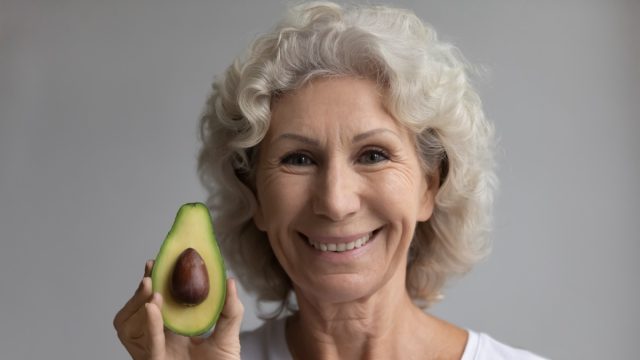
Losing weight is more than just calories in, calories out, especially once you hit 50 and your metabolism might start to slow down. "Not all people over 50 will experience the same degree of difficulty with weight loss as genes determine 40 to 70 percent of what your weight is at a given time," Holly Lofton, MD, director of the NYU Langone Medical Weight Management Program in New York City, tells AARP. If you are one of those struggling with weight gain, lifestyle changes can make a huge difference. How you eat lunch can affect your health and your waistline after 50—here are 10 lunchtime routines that can help you slim down.
Eat At the Table

Don't eat your lunch on the go—sit down at the table and take time to enjoy it. "When a family sits down together, it helps them handle the stresses of daily life and the hassles of day-to-day existence," says Stanford Medicine. "Eating together tends to promote more sensible eating habits, which in turn helps family members manage their weight more easily."
Have Lunch With Friends
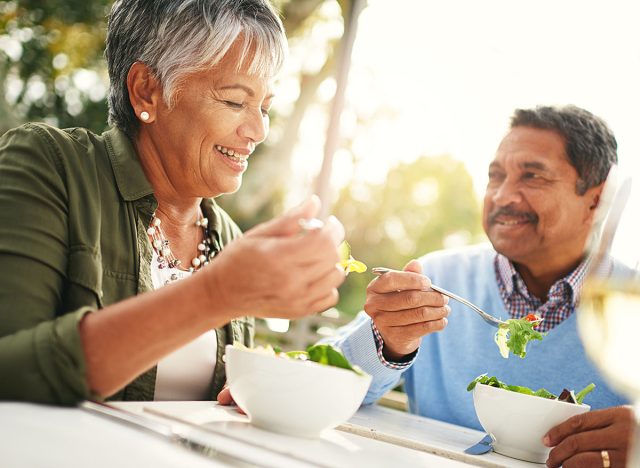
Using your lunch time to be social is important, especially if you're retired or work from home. "People who eat together are more likely to have a ritual before, such as giving thanks. And food rituals can help us eat better," Maty Beth Albright tells the Washington Post.
Take a Walk After Lunch

Studies show taking even a short walk after a meal can help lower blood sugar levels. "Exercise impacts your blood sugar quickly, often within a few minutes," Shannon Knapp, MEd, BSN, RN, CDCES, tells the Cleveland Clinic. "And over time, physical activity helps your body use insulin more effectively, decreasing the insulin resistance we often see in diabetes."
No Screens
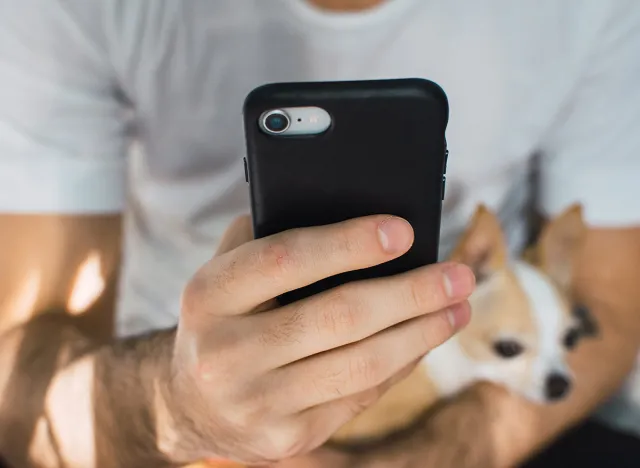
Try not to eat lunch in front of your computer, as you may get distracted into eating more than you intended. "Increases in screen time have been linked with unhealthy habits, such as eating more junk food, physical inactivity, poor sleep patterns and decreased social interaction," says Ingrid Adams, an Ohio State University Extension specialist in Food, Health and Human Behavior in the College of Food, Agricultural, and Environmental Sciences at The Ohio State University. "As a family, it is important to set healthy limits and boundaries for screen use, particularly when it comes to meal times."
Eat a Home-Cooked Meal
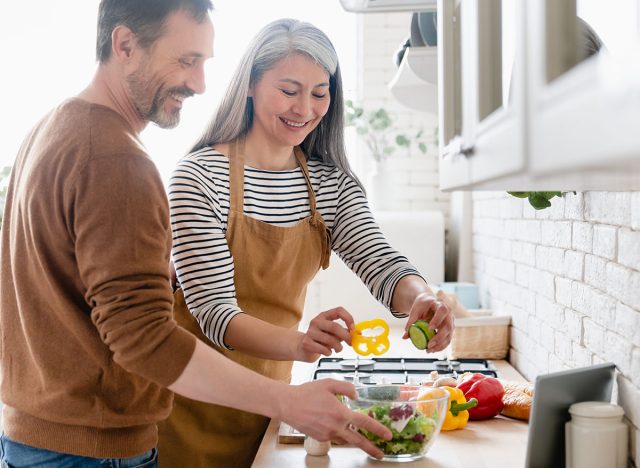
Studies show home-cooked meals are often healthier than eating out. "When people cook most of their meals at home, they consume fewer carbohydrates, less sugar and less fat than those who cook less or not at all – even if they are not trying to lose weight," Julia A. Wolfson, MPP, tells Johns Hopkins. "Obesity is an escalating public health problem that contributes to other serious health issues, including diabetes, high blood pressure and heart disease. The evidence shows people who cook at home eat a more healthy diet."
Skip the Cocktail

Drinking in the middle of the day may slow you down and encourage eating foods you normally wouldn't have for lunch. It also gives your metabolism a hit. Why? while your body is breaking down the alcohol, it won't be digesting your food.
RELATED: 15 Quick Ways to Lose Body Fat Percentage in a Week
Don't Skip Lunch
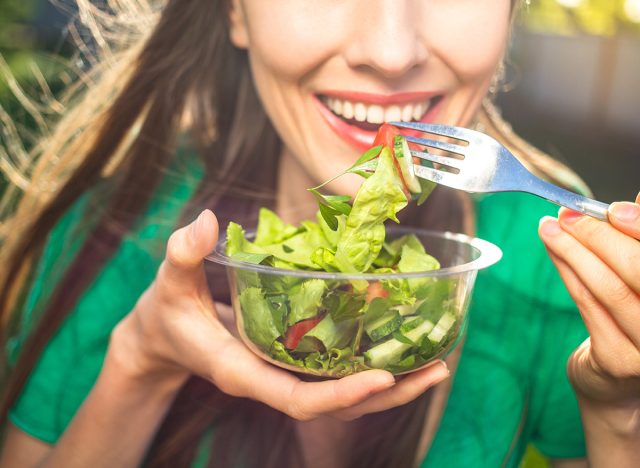
Skipping lunch can cause low blood sugar, experts say. "The brain depends on glucose for fuel," registered dietitian Amanda Spina tells Banner Health. "Glucose comes either directly from carbohydrate-containing foods and drinks or indirectly from glucose stores and glucose production in the liver. Your brain can use ketones, which are compounds created by the liver after breaking down fats, but your brain much prefers to get its energy from glucose."
Drink Water

Drinking water with your lunch will help digestion and metabolism. "Water is vital for good health," Michael F. Picco, MD, tells the Mayo Clinic. "Water and other drinks help break down food so that your body can take in (absorb) the nutrients. Water also makes stool softer, which helps prevent constipation. Choose water when possible instead of drinks full of sugar.
Don't Eat At Your Desk
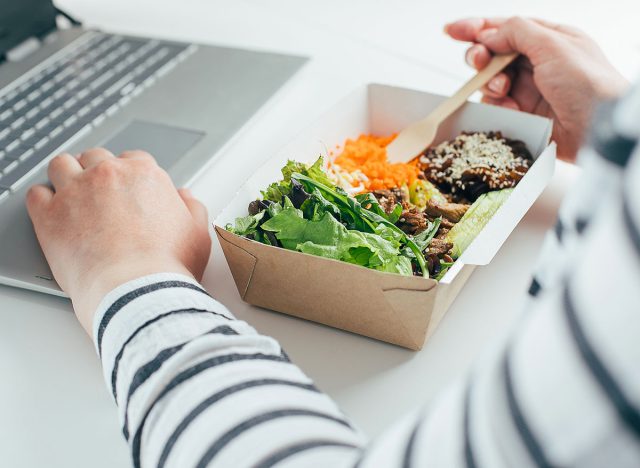
Don't be tempted to eat at your work desk. "If you eat at your desk when you're distracted through working, and you're not giving yourself a proper lunch break, then the food you eat doesn't fill you up as much," Jane Ogden, professor in health psychology from the University of Surrey, told Wired. "You don't remember that you have eaten in the same way, and you don't code food in the same way. You're more likely to feel hungry in the afternoon and then eat more."
RELATED: I Lost 15 Pounds in 30 Days by Following 3 Simple Steps
Eat Protein First
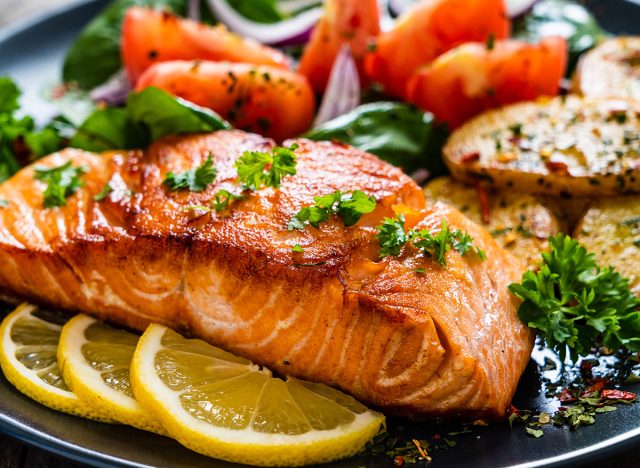
Studies show eating protein and vegetables before carbohydrates impact insulin and blood sugar. "The takeaway here is that you can protect your blood glucose levels on multiple fronts," Eve M. Glazier, MD, and Elizabeth Ko, MD, tell UCLA Health. "It is still important to limit consumption of simple carbs. That includes snack foods, highly processed foods, and those with added sugars. Consider beginning a meal with a salad or fresh vegetables, save the simple carbs for last, and remember to eat slowly."
💪🔥Body Booster: Sit down to eat at a table, preferably with friends and family. And if you enjoyed this article, take advantage of these 20 Superfoods for People Over 50.




